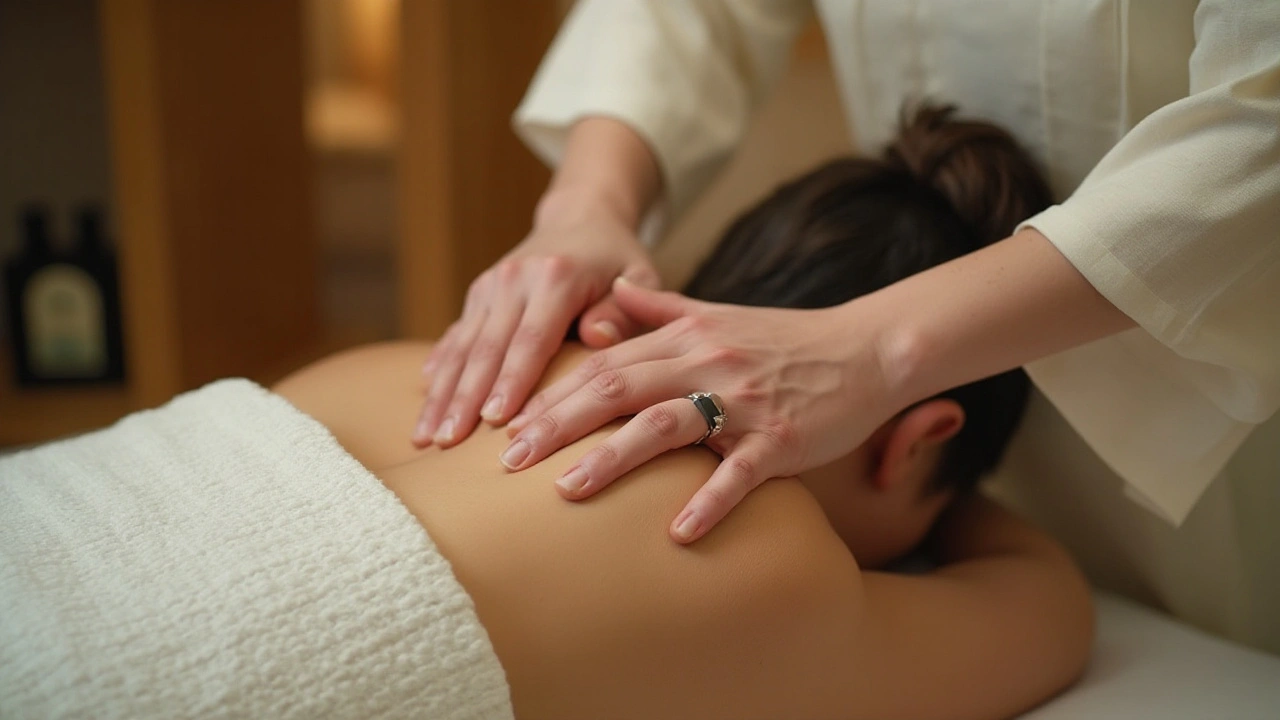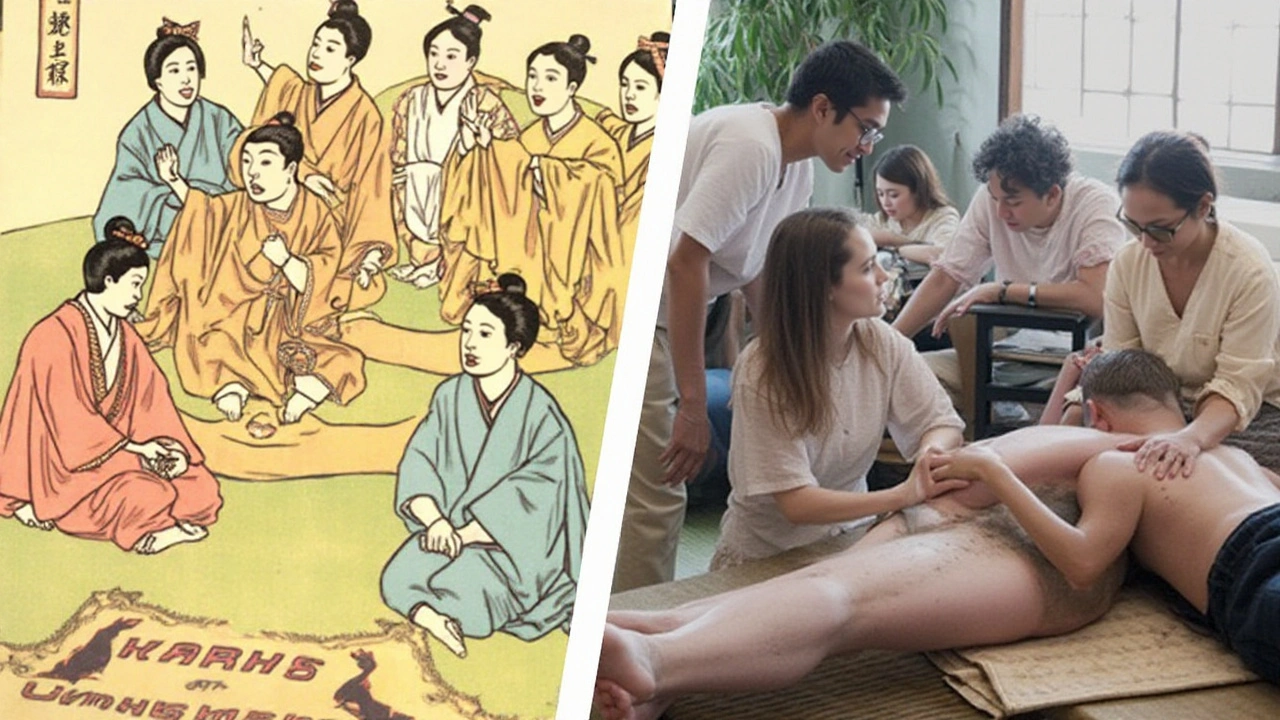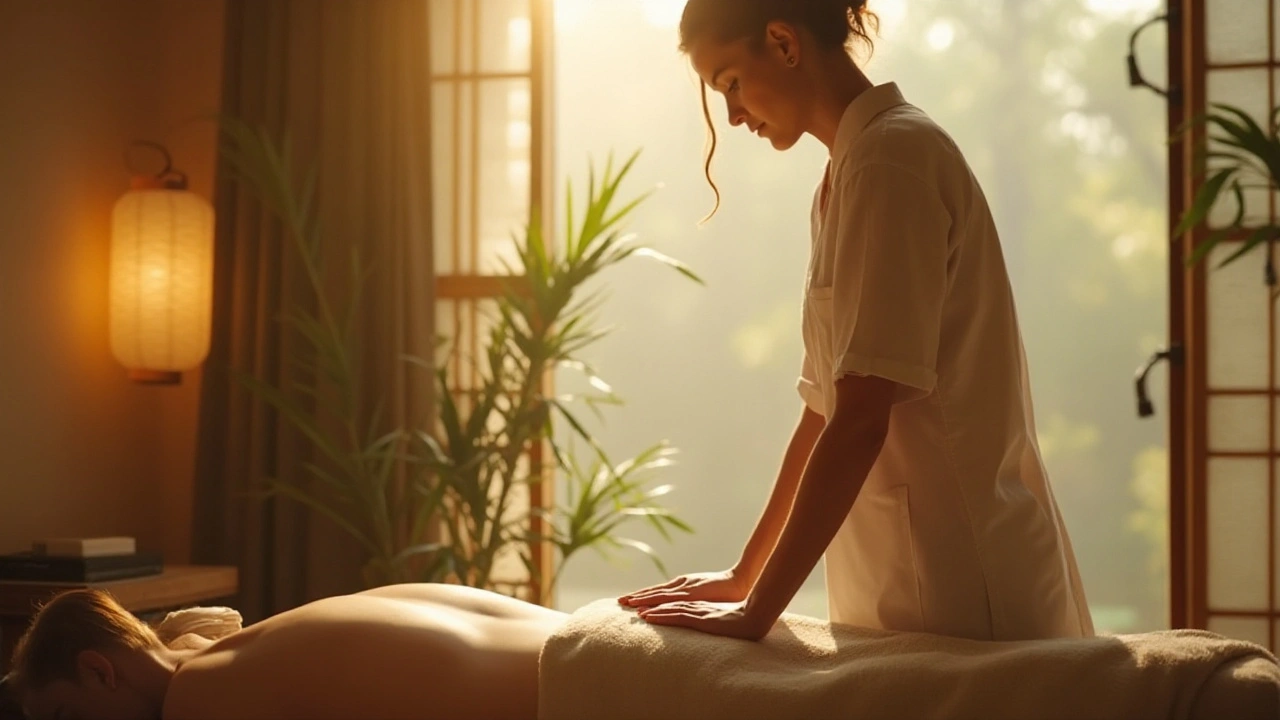Chronic pain is something many people wrestle with daily, often seeking solutions that seem just out of reach. Enter shiatsu, an ancient Japanese therapy that has been helping individuals find relief in more ways than one. This therapeutic method is not just about healing the body but also about centering the mind.
Shiatsu, translated to mean 'finger pressure,' involves skilled motions of applying pressure using thumbs, palms, elbows, knees, and even feet across a person's body. It works by promoting circulation and fostering the body's natural energy flow, which is crucial for pain relief.
This article unveils what shiatsu has to offer and why it might be the missing piece in your pain management puzzle. Learn how this traditional practice can become a transformative part of your wellness journey.
- The Origins of Shiatsu
- How Shiatsu Works
- Benefits for Chronic Pain
- Finding a Qualified Practitioner
- Tips for a Successful Shiatsu Session
The Origins of Shiatsu
The story of shiatsu begins in the bustling era of early 20th century Japan, though its roots can be traced even further back into the ancient wisdom of traditional Chinese medicine. This therapeutic art form was born from 'anma,' a type of traditional massage. Anma had already been a part of Japan's healing methods for centuries, after having journeyed across from China. It was known for its rhythmic pressure and soothing manipulations, designed to unblock the body's channels of energy known as qi (or chi in Chinese terms).
As Japan entered the modern age, a shift began - there was a desire to harness and adapt these time-tested techniques to benefit the rapidly changing lifestyle and health needs of people. It was during this period that a visionary named Tokujiro Namikoshi began to innovate and refine the practices he had learned from anma. In fact, Namikoshi, at the tender age of seven, first utilized his healing touch to relieve his mother’s rheumatoid arthritis, laying the foundation for what we now recognize as shiatsu. Later, he would formalize his teachings and establish the Japan Shiatsu College, bringing structure and broad acceptance to this healing art.
“Shiatsu is like an art: it requires devotion, patience, and continuous practice to master.” — Paul Lundberg, a renowned shiatsu therapist
Namikoshi's development of the shiatsu method was a simplified approach focused on using the thumbs and palms. This distinguished it from anma and other forms of massage through its explicit emphasis on anatomical influences rather than relying on the traditional energy lines. This simplification and focus not only brought relief to physical ailments but also provided a unique, gentle, and yet deeply effective approach to addressing chronic pain. The Ministry of Health in Japan officially recognized shiatsu in the 1960s, enabling its spread and integration into modern medical practices internationally.
Moreover, while Namikoshi’s approach gained esteem, practitioners like Shizuto Masunaga further nuanced the practice by reintroducing the concept of energetic pathways, a blend often referred to as Zen shiatsu. This version emphasizes not just physical but also spiritual practices, providing a holistic encounter that is deeply resonant with the philosophy that the body is not separate from the mind and spirit.
As people continue to seek alternative ways to manage health in a modern world, the blend of ancient knowledge and modern understanding makes shiatsu an enduring and increasingly popular option for those suffering from chronic pain. Its rich history and transformative journey underscores a broader narrative that tradition, when rightly adapted, can provide effective solutions to contemporary challenges.
How Shiatsu Works
Imagine a therapy that doesn't just target the symptoms but dives into the root causes of chronic pain. Shiatsu does just that by focusing on the energy flow within the body, also known as 'chi.' Central to its practice is the belief that disruptions in this natural flow can lead to discomfort or illness. Practitioners use their fingers or palms to apply pressure to specific points, known as acupoints, along the body’s meridians. This gentle pressure helps unblock energy pathways, enabling the body to heal itself naturally and effectively.
Integrating the principles of traditional Chinese medicine, shiatsu therapy isn’t just about the pressure applied. It's a holistic approach encompassing many techniques, including stretching, holding, and picking. These manual techniques improve circulation and enhance flexibility, delivering a comprehensive package of health benefits. The gentle yet firm application of pressure helps reduce muscle tension and encourages relaxation, acting as a bridge between physical well-being and mental tranquility.
Research indicates that this method can be particularly beneficial in managing chronic conditions such as arthritis, back pain, and fibromyalgia. By emphasizing particular areas on the body, shiatsu enhances the production of endorphins, which act as the body’s natural painkillers. This approach has shown promise in reducing the need for pain medications, offering an appealing alternative for those seeking natural remedies. With each session, individuals often notice a reduction in muscle stiffness, an increase in energy levels, and an improved mood. A study published in the Journal of Alternative and Complementary Medicine highlights how regular shiatsu sessions can significantly improve pain thresholds and quality of life for those suffering from persistent pain ailments.
One essential element of shiatsu that differentiates it from other forms of therapy is its emphasis on the connection between the practitioner and the recipient. The practitioner's role is as a facilitator for the body’s healing processes. This therapeutic relationship is vital, reflecting the ancient philosophy of balance and harmony. It's interesting to note that many practitioners of shiatsu often say, “Healing is a dialogue” because it involves a partnership between the person providing the treatment and the person receiving it.
For those who are new to shiatsu and considering trying it to alleviate their pain, it is vital to find a licensed and experienced practitioner. While shiatsu is safe for most individuals, it is always recommended to consult with a healthcare provider, especially if you have specific medical conditions or concerns. Shiatsu is a harmonious blend of art and science, offering a nuanced means of aiding the body's natural pathways to heal and rejuvenate. As more research elucidates its benefits, it continues to gain popularity amongst those who seek a more natural and holistic way to manage chronic pain.

Benefits for Chronic Pain
Chronic pain is a master of persistence, frequently accompanying individuals through countless experiences, quietly dulling life’s brightness. Many people spend years searching for a remedy that offers solace without the burden of side effects. It is here that shiatsu steps into the spotlight, providing a holistic approach that's stood the test of time. This ancient method addresses pain not by masking it but by diving deep into the body's energetic processes to restore balance and harmony.
One of the key distinctions of shiatsu is its emphasis on the energy pathways known as meridians. By applying pressure to specific points along these lines, shiatsu practitioners aim to unblock and redirect the flow of energy through the body. This is not just a spiritual perspective; scientific studies suggest this method encourages the release of endorphins, the body's natural painkillers, offering significant relief to those suffering from chronic pain without the use of pharmaceuticals.
Those who have turned to shiatsu often report profound improvements. Many recount having more energy, better sleep, and an enhanced sense of well-being. Understanding the therapeutic aspects of shiatsu is crucial to appreciating why it works so effectively for chronic pain. It doesn’t just focus on the symptom but rather empowers the body to heal itself by addressing the root causes, such as stress and tension, which are often lodged in the musculoskeletal system.
A 2022 study from the Touch Research Institute showed participants who underwent regular shiatsu treatments experienced a significant reduction in symptoms associated with chronic pain disorders like fibromyalgia. It's important to note that
"Shiatsu provides a gentle and non-invasive approach to pain management, helping patients improve their quality of life significantly," says Dr. Yuki Matsumoto, a holistic health practitioner.
The benefits extend beyond just pain relief. Patients often find that their posture improves, joint stiffness decreases, and their immune function is bolstered. Many practitioners have noticed that by aligning the body's energy systems, shiatsu helps to prevent the recurrence of pain, offering a more long-term solution as opposed to temporary relief. This sets a path for a future where pain doesn't dictate daily actions but rather becomes a manageable part of life.
While modern medicine struggles with chronic pain solutions, the ancient art of shiatsu offers a gentle yet powerful means of addressing this pervasive problem. By considering shiatsu, those with chronic pain can find an empowering path to not only reduce their suffering but also reclaim control over their lives.
Finding a Qualified Practitioner
Venturing into the realm of shiatsu therapy requires not just curiosity but also trust. It's essential to ensure that the practitioner you choose is both skilled and certified. But how exactly do you go about finding the right fit for you? The quest often starts online where a wealth of resources promise to point you in the right direction. However, it’s important to look beyond mere digital introductions. Digging deeper, research credentials and affiliations—seeking those who have been trained in reputable institutions often speaks volumes about their dedication and credibility.
In your search, look out for members of recognized associations, such as the American Organization for Bodywork Therapies of Asia (AOBTA) if you are based in the US. These associations require rigorous training hours and adherence to a strict code of ethics, ensuring that their members practice with the highest standards. Word of mouth is another invaluable resource—consider reaching out to friends or family who have experienced shiatsu therapy firsthand. They can offer insights not available elsewhere, sharing honest appraisals of their experiences.
According to the AOBTA, "Ensuring that your practitioner is fully certified adds an additional layer of confidence to your shiatsu experience, allowing you to fully relax and embrace the healing process."
While engaging with potential therapists, don’t hesitate to inquire about their experience with chronic pain management. Ask questions about techniques and methodologies that are implemented specifically for pain relief. Many will offer an initial consultation or trial session, providing you an opportunity to gauge comfort levels and their ability to understand your needs. It's also crucial to evaluate their communication style, as this can greatly influence the effectiveness of your sessions. Effective practitioners often possess a keen ability to listen actively and adapt their approach depending on your feedback.
Once you have shortlisted a few practitioners, the next phase is deciding and embarking on your healing journey. The rights practitioner won’t just apply pressure, they’ll educate you about your body, empowering you to take part in your healing journey. This symbiotic relationship is an aspect that cannot be underestimated, as it fosters not just relief but also a deeper understanding of one's own physiology. Prices may vary significantly, so be sure to confirm rates upfront and discuss potential packages if you foresee long-term treatment. Occasionally, certain health insurance plans might cover natural therapy, so it's worth checking with your provider.
Indeed, selecting a qualified shiatsu practitioner who is ethically driven and well-trained, is key to maximizing the benefits of this ancient therapy. Your path to healing is a personal voyage, making it essential to choose a guide who aligns with your therapeutic goals. It's not just about finding relief; it's about nurturing a holistic balance that continues to enrich your life long after the session ends.

Tips for a Successful Shiatsu Session
Embarking on a shiatsu journey is like stepping into a world where touch communicates more deeply than words. To get the most out of your shiatsu experience, a few simple tips can ensure not only success but perhaps a transformative moment in your chronic pain management. Before you even enter the studio, understanding what your body needs and how shiatsu can help is paramount. It's vital to have a clear intention of what you're hoping to achieve, be it relief from chronic pain or just a peace of mind. Make sure to communicate any specific areas of discomfort to your therapist, as their tailored approach could make all the difference.
Wear loose, comfortable clothing to your session; shiatsu is often performed over clothing and involves stretching, joint rotation, and pressure points. This requires minimal restriction from attire so your practitioner can work effectively on your natural therapy needs. Plan to arrive at least ten minutes early to allow yourself to decompress a bit—rushing only sends a signal to your mind and body that it’s not quite time to relax yet. Turning off your electronic devices can also be a game-changer. Imagine spending an hour free from the pings and alerts of technology; this allows focus purely on inner healing processes.
It's also important to approach your session with an open mind. Shiatsu, much like yoga or meditation, may not provide immediate results for everyone. Its effects can be cumulative, enhancing your body’s own ability to restore balance as sessions progress. Some might feel significant improvement by the end of their first session, while others gradually notice relief from pain and tension over time. Hydrating well both before and after the therapy is key—it aids in flushing out toxins that the treatment helps release. A post-session relaxation period is equally beneficial. Aim to minimize strenuous activities immediately following your appointment for best results.
"Shiatsu is not just a healing method; it’s a philosophy of life akin to counseling methods." — Pauline Sasaki, a renowned shiatsu practitioner.
If pain continues after several sessions, a well-known consideration is to examine your overall lifestyle. Look at factors like diet, exercise, and stress management—these components work in tandem with healing practices. Consider keeping a journal of your experiences, noting sensations and improvements you feel post-treatment. This can guide your therapist in fine-tuning their techniques and allow you observable progress over time.
By implementing these tips, you can maximize the benefits of shiatsu and potentially see reductions in those persistent pain levels. The goal is not just relief but to nurture a meaningful connection with your body’s innate ability to heal itself. With patience and dedication, shiatsu could be the natural relief your body has been yearning for.

